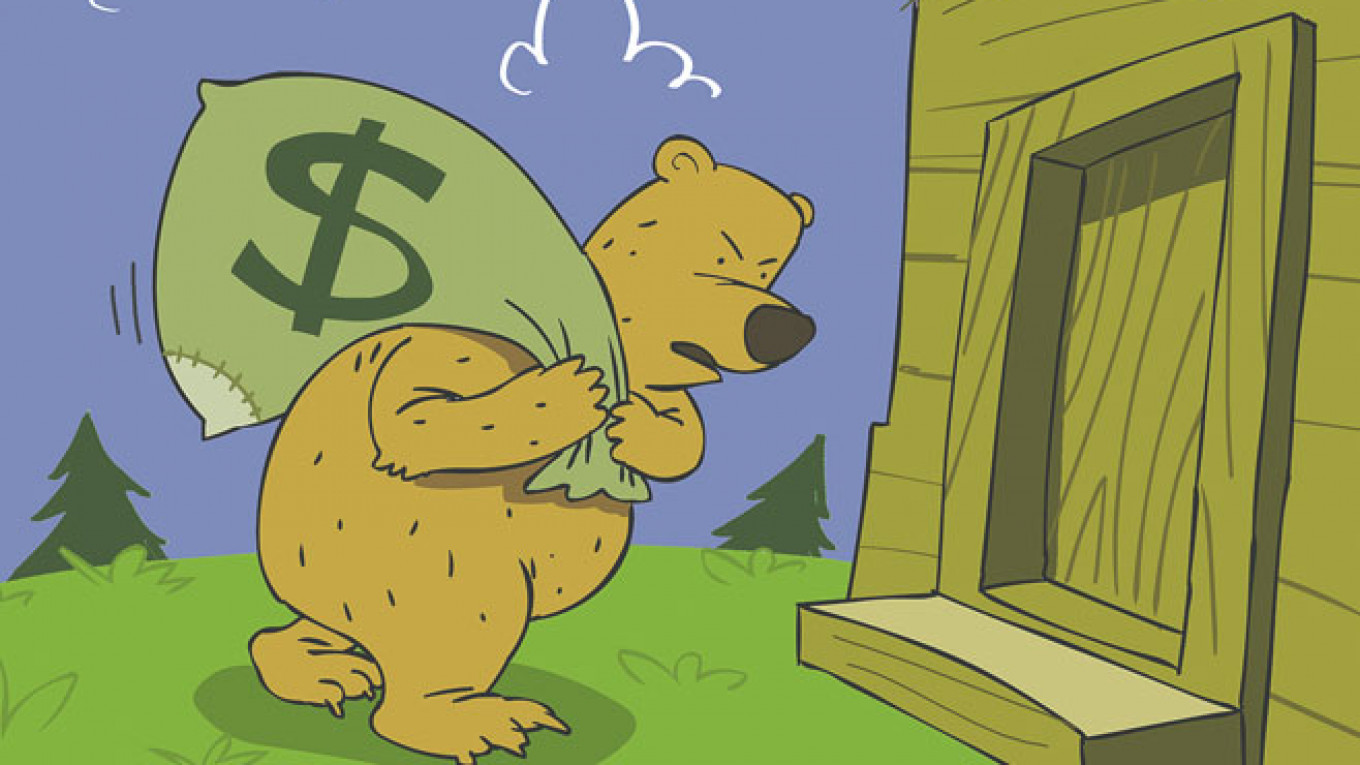When a Moscow Times reporter asked me in January about the likely direction of the ruble for the year, I stuck an old trader's finger in the wind and predicted it was headed to 37 rubles to the U.S. dollar. Well sure. For the year. But I never expected it to happen by March. Is it time to panic yet?
Monday saw the markets gunning for the ruble on the back of the Crimean crisis. From all the selling it seemed like the ruble isn't even worth a ruble anymore. The currency almost reached the 37 mark before the Central Bank began to intervene.
Monday's market turmoil was just a hyperextension of a trend that has been gathering steam for some time.
The Central Bank intervened in two ways. It sold nearly $10 billion, buying rubles, to drive the price back to 36.5 to the dollar. This had the effect of stopping the momentary panic that had developed. But before doing that, the bank raised the base interest rate by 1.5 percent. "Smart money" calls this "150 basis points." Whatever you call it, this was a really large interest rate jump for one day.
The intuition behind this decision was that if you offer a high enough yield, people will sell the currently low-earning currency and buy it at a higher yield. In calm markets this sort of measure will work on only a one-fourth percent, or 25 basis points, increase. Here the Central Bank bumped up rates by six times that amount and, surprisingly, that did not work to brake the ruble's skid.
Like any smart financial guy, I keep a large amount of my money in the currency where I live — Russia. So what happened to my rubles?
Fear and pain following Russia's military intervention in Ukraine last weekend is obviously a factor. Clearly some market players were expecting some sort of backlash from the world regarding Russia's moves. There was the usual talk of U.S. sanctions, presumably to fall on Russian state banks. When it comes to financial sanctions, it is hard to dream up a government player more scary and dangerous than Uncle Sam, and any action against Russia could leave a lot of folks high and dry. Naturally, smart guys would buy dollars and move them out if they feared sanctions, thus contributing to flush the ruble out. But this is not sufficient to explain the crash.
But the plain fact is that Monday's market turmoil was just a hyperextension of a trend that has been gathering steam for some time. The ruble is being punished for the sins of the Russian economy.
Any banker who is free to talk nowadays will tell you that corporates are simply not borrowing the way they used to. More generally, people are not investing into their own businesses and have not been for more than two years. Increasingly, company directors, entrepreneurs and the like have been "milking" their businesses in Russia and getting the money out of the country any way they can. This is called capital flight with a capital "F" and has been going on in Russia increasingly over the past two years.
It is malaise that has led to underinvestment, which in turn reinforces the negative mindset. Capital flight is accomplished by buying an international convertible currency such as the dollar and sending it out in some manner. To do this, you have to sell the ruble. When a lot of selling goes on, especially over a long period of time, the ruble goes down. That is the "short" of it.
So what we all saw on Monday was a hyperextension, a ruble-selling panic cap, combining an ongoing trend with the "flight to quality" that accompanies an economic or political crisis. The dollar is like a new gold, something the markets latch onto in a "buying panic" during crises. That is the "long" of it.
So will it stop here? To my old trader's eye, the dollar blow-off on Monday represented a local low for the ruble, and I would expect a welcome, temporary correction as cooler heads prevail for the moment. Longer run, I expect the ruble to resume its downward trend. I looked for, and still look for a rate of 37 rubles to the dollar. Others are looking for worse.
What to do? Logically, if you need rubles for your life, you should keep them more or less in the ratio to your other currency that corresponds to your needs, not your speculative desires. It does not seem to be the time to panic. An old Wall Street adage goes, "Don't panic, but if you have to panic, panic first!" Too late for that now. So if you have rubles to sell and do not know what to do, you can follow an adage of mine, "When you don't know what to do, do half."
Philip M. Halperin is an independent risk adviser and former chief risk officer at Alfa Bank.
A Message from The Moscow Times:
Dear readers,
We are facing unprecedented challenges. Russia's Prosecutor General's Office has designated The Moscow Times as an "undesirable" organization, criminalizing our work and putting our staff at risk of prosecution. This follows our earlier unjust labeling as a "foreign agent."
These actions are direct attempts to silence independent journalism in Russia. The authorities claim our work "discredits the decisions of the Russian leadership." We see things differently: we strive to provide accurate, unbiased reporting on Russia.
We, the journalists of The Moscow Times, refuse to be silenced. But to continue our work, we need your help.
Your support, no matter how small, makes a world of difference. If you can, please support us monthly starting from just $2. It's quick to set up, and every contribution makes a significant impact.
By supporting The Moscow Times, you're defending open, independent journalism in the face of repression. Thank you for standing with us.
Remind me later.






